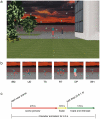Tempo rubato : animacy speeds up time in the brain
- PMID: 21206749
- PMCID: PMC3012081
- DOI: 10.1371/journal.pone.0015638
Tempo rubato : animacy speeds up time in the brain
Abstract
Background: How do we estimate time when watching an action? The idea that events are timed by a centralized clock has recently been called into question in favour of distributed, specialized mechanisms. Here we provide evidence for a critical specialization: animate and inanimate events are separately timed by humans.
Methodology/principal findings: In different experiments, observers were asked to intercept a moving target or to discriminate the duration of a stationary flash while viewing different scenes. Time estimates were systematically shorter in the sessions involving human characters moving in the scene than in those involving inanimate moving characters. Remarkably, the animate/inanimate context also affected randomly intermingled trials which always depicted the same still character.
Conclusions/significance: The existence of distinct time bases for animate and inanimate events might be related to the partial segregation of the neural networks processing these two categories of objects, and could enhance our ability to predict critically timed actions.
Conflict of interest statement
Figures








Similar articles
-
The Ventral Visual Pathway Represents Animal Appearance over Animacy, Unlike Human Behavior and Deep Neural Networks.J Neurosci. 2019 Aug 14;39(33):6513-6525. doi: 10.1523/JNEUROSCI.1714-18.2019. Epub 2019 Jun 13. J Neurosci. 2019. PMID: 31196934 Free PMC article.
-
Discrimination of animate and inanimate motion in 9-month-old infants: an ERP study.Dev Cogn Neurosci. 2013 Oct;6:14-22. doi: 10.1016/j.dcn.2013.05.003. Epub 2013 Jun 7. Dev Cogn Neurosci. 2013. PMID: 23811318 Free PMC article.
-
Encodings of implied motion for animate and inanimate object categories in the two visual pathways.Neuroimage. 2016 Jan 15;125:668-680. doi: 10.1016/j.neuroimage.2015.10.059. Epub 2015 Oct 24. Neuroimage. 2016. PMID: 26505302
-
How long did it last? You would better ask a human.Front Neurorobot. 2014 Jan 27;8:2. doi: 10.3389/fnbot.2014.00002. eCollection 2014. Front Neurorobot. 2014. PMID: 24478694 Free PMC article. Review.
-
Considerations on perception of "animacy" in the motion of a single object.Percept Mot Skills. 2004 Dec;99(3 Pt 1):1014-26. doi: 10.2466/pms.99.3.1014-1026. Percept Mot Skills. 2004. PMID: 15648503 Review.
Cited by
-
Dilation and Constriction of Subjective Time Based on Observed Walking Speed.Front Psychol. 2018 Dec 21;9:2565. doi: 10.3389/fpsyg.2018.02565. eCollection 2018. Front Psychol. 2018. PMID: 30627109 Free PMC article.
-
Temporal Context Influences the Perceived Duration of Everyday Actions: Assessing the Ecological Validity of Lab-Based Timing Phenomena.J Cogn. 2018 Jan 9;2(1):1. doi: 10.5334/joc.4. J Cogn. 2018. PMID: 31517220 Free PMC article.
-
Long- and short-term plastic modeling of action prediction abilities in volleyball.Psychol Res. 2012 Jul;76(4):542-60. doi: 10.1007/s00426-011-0383-y. Epub 2011 Nov 2. Psychol Res. 2012. PMID: 22045443
-
Observing human movements helps decoding environmental forces.Exp Brain Res. 2011 Nov;215(1):53-63. doi: 10.1007/s00221-011-2871-0. Epub 2011 Sep 27. Exp Brain Res. 2011. PMID: 21947172
-
Symmetrical and asymmetrical distortions in time and numerosity perception induced by chunked stimuli.J Vis. 2025 Aug 1;25(10):1. doi: 10.1167/jov.25.10.1. J Vis. 2025. PMID: 40747968 Free PMC article.
References
-
- Georgopoulos AP. Cognitive motor control: spatial and temporal aspects. Curr Opin Neurobiol. 2002;12:678–83. - PubMed
-
- Mauk MD, Buonomano DV. The neural basis of temporal processing. Annu Rev Neurosci. 2004;27:307–40. - PubMed
-
- Buhusi CV, Meck WH. What makes us tick? Functional and neural mechanisms of interval timing. Nat Rev Neurosci. 2005;6:755–65. - PubMed
-
- Nobre A, Correa A, Coull J. The hazards of time. Curr Opin Neurobiol. 2007;17:465–70. - PubMed
Publication types
MeSH terms
LinkOut - more resources
Full Text Sources

